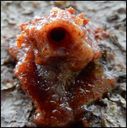Spruce Beetle
Dendroctonus rufipennis
Classification
- Phylum: Arthropoda
- Subphylum: Hexapoda
- Class: Insecta
- Order: Coleoptera
- Suborder: Polyphaga
- Superfamily: Curculionoidea
- Family: Curculionidae
- Subfamily: Scolytinae
- Tribe: Hylurgini
- Genus: Dendroctonus
- Species: rufipennis
Pronunciation
How to pronounce Dendroctonus rufipennis: //dɛnˈdrɑktənəs ruːfɪˈpɛnɪs//
These audio files are automatically generated. While they are not always 100% accurate, they are a good starting point.
Images






Summary
Dendroctonus rufipennis, known as the spruce beetle, is a bark beetle species that targets spruce trees, contributing to significant forest destruction across North America, especially in response to environmental changes leading to increased populations.
Physical Characteristics
Adults average 4 to 7 mm in length; frons is closely granulate and coarsely punctate.
Identification Tips
The presence of red boring dust in bark crevices and pitch tubes indicate an attack, especially on weakened or recently dead trees.
Habitat
Primarily found in forests comprised of spruce trees such as Engelmann, White, Sitka, and Colorado blue spruce.
Distribution
Transcontinental across Canada and Alaska, down the Rockies to New Mexico, affecting various regions including British Columbia, Newfoundland and Labrador, Nova Scotia, Ontario, Quebec, Northern Manitoba, and parts of the U.S. such as Colorado, Wyoming, Montana, and Maine.
Diet
Feeds on the inner bark of spruce trees, primarily targeting weakened or recently dead individuals.
Life Cycle
The spruce beetle has a life cycle that can last 1, 2, or 3 years, with the 2-year cycle being the most common. They are most active during the flight and attack period starting in June, and adults emerge in summer or fall.
Reproduction
Females lay about 100 eggs per gallery in 3 to 4 groups, and larvae develop through winter, resuming growth the following year.
Ecosystem Role
As an important forestry pest, they play a role in forest dynamics by affecting the population of spruce trees in their habitat.
Economic Impact
Significant impact on the forestry industry, causing the destruction of millions of trees and loss of timber resources.
Similar Taxa
Misconceptions
Some may mistakenly believe that only older trees are affected, whereas young trees can also be at risk if conditions favor the beetle's presence.
Tags
- Dendroctonus rufipennis
- Spruce Beetle
- Forestry Pest
- Bark Beetle
- Insecta